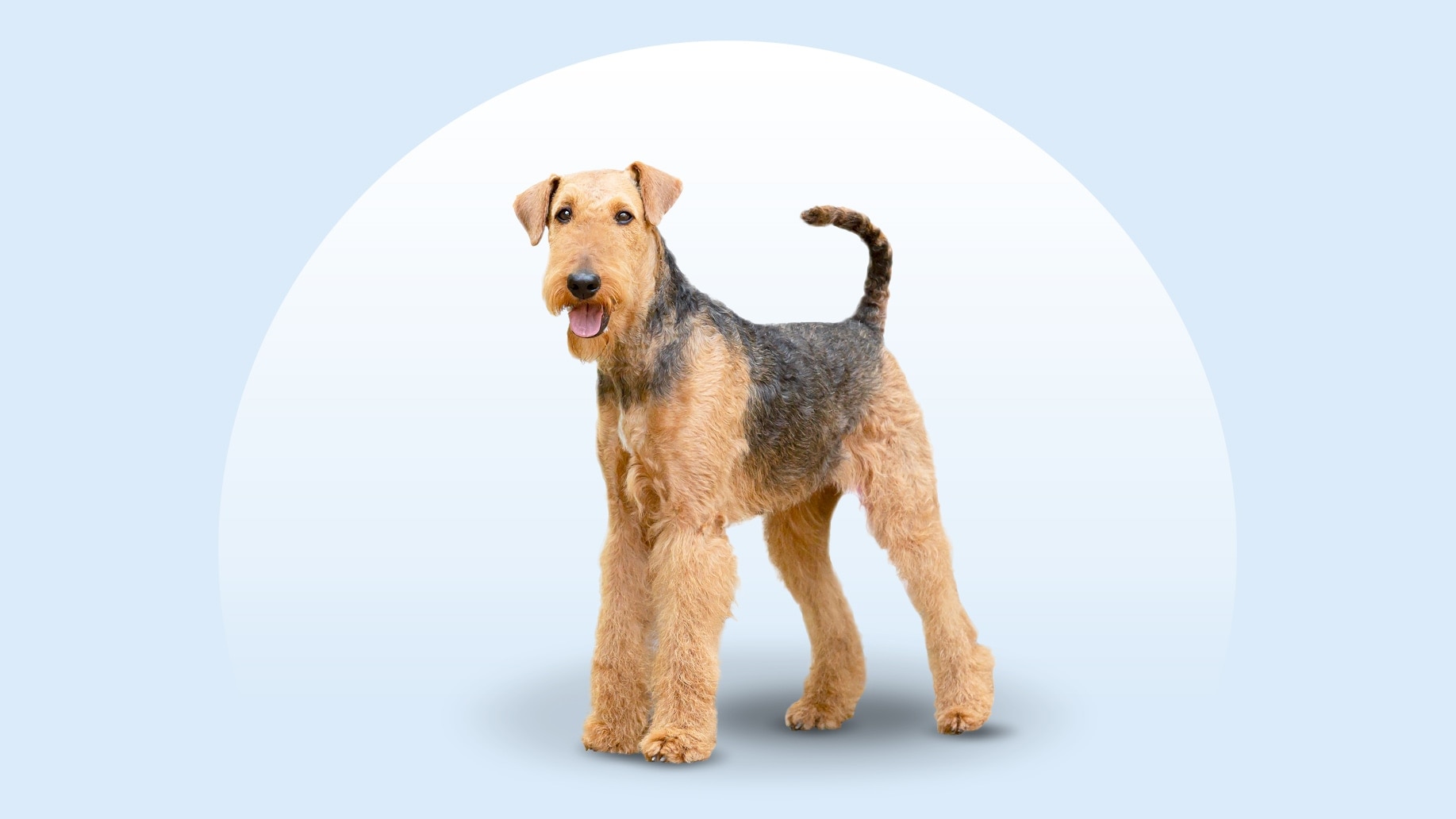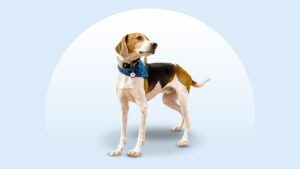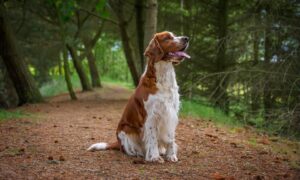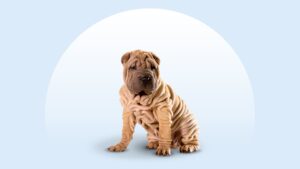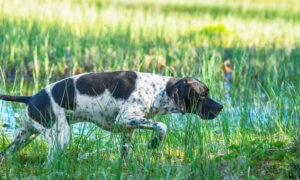Airedale Terrier
Updated May 5, 2025
Airedale Terrier
Updated May 5, 2025
The Airedale Terrier is an agile and intelligent breed, originally bred as a hunting dog in England. Known for their athleticism, bravery, and distinct black-and-tan coat, the "King of Terriers" makes a loyal companion and family dog.
Intelligent, Spirited, Loving
Male: 50-70 pounds
Female: 50-70 pounds
Male: 23 inches
Female: a little shorter
11 to 14 years
Black and Tan, Grizzle and Tan
Brave and knightly, you might as well call your Airedale King Arthur. Nicknamed the “King of Terriers,” this English-born breed is the largest of all terrier breeds and is known for their intelligence, determination, strength and athleticism. Take them swimming, jogging or on any adventure fit for a king. Their Majesty will reward you with eternal love and loyalty.
Airedale Terrier Characteristics
Airedale Terrier Appearance
The overall look of the Airedale Terrier definitely says “terrier,” even though they’re larger than the other terrier breeds. Medium in size, they have a sturdy, muscular build, that conveys strength and agility. Airedales have a distinctive-shaped head with a flat skull; long muzzle with black nose; small, dark eyes and folded, V-shaped ears. Their fur is dense and wiry, mainly tan in color with darker fur on the sides and upper parts of the body. And you can’t forget their trademark beard.
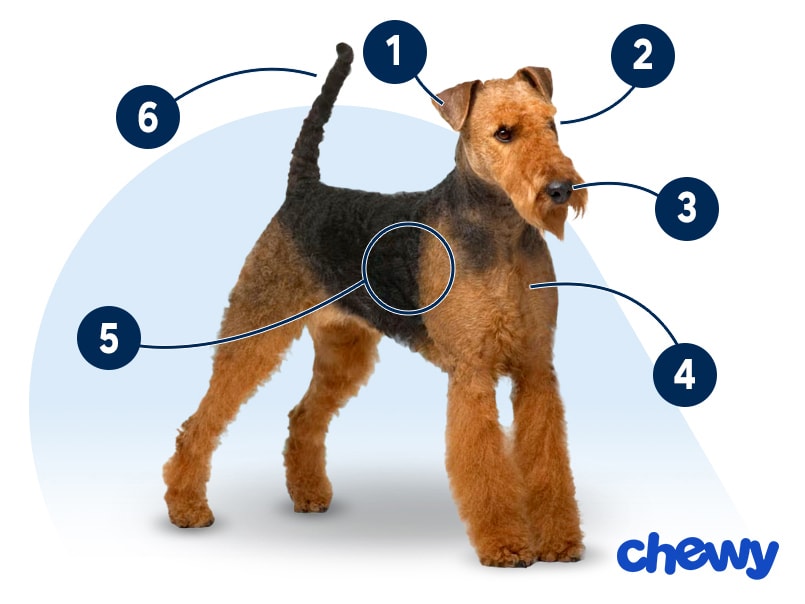
- Ears
The Airedale Terrier's V-shaped ears hang down the side of their head.
- Eyes
Their eyes are small, dark and expressive.
- Nose
An Airedale Terrier's nose is black and the overall shape of their muzzle is wide with a slight taper.
- Coat Length
The Airedale has a short coat, double-layered coat that's soft underneath and wiry on top.
- Coat Color
Their colors are typically tan with a darker “saddle" marking around their middle. There are only two types: black and tan and grizzle (blended colors) and tan.
- Tail
Their tail is moderately short and high-set and shouldn't curl over their backs.
Airedale Terrier Temperament
Like most terriers, Airedale Terriers have a feisty spirit. Bred to hunt docks and rats, they’re determined, athletic and super intelligent. And thanks to this, they excel in whatever they put their mind to.
Most Airedales love family life and accept children when properly introduced and socialized. They tend to be good around dogs they know but are sometimes wary around dogs they don’t know. And with the Airedale Terrier breed’s innate hunting instincts, having a cat in the household can be tricky.
“But wait!” adds the Airedale, “Tell them how talented I am!” Airedales have an impressive work resume as police dogs. It’s been said they can do anything, and that includes agility, dock diving, hunting, flyball, tracking, scent work, search and rescue, obedience and therapy work. (Whew!)
How to Care for a Airedale Terrier
Airedale Terrier dogs have low-maintenance coats and moderate grooming needs, but you’ll need to factor in plenty of time for exercise, training and playtime—they’re intelligent, high-energy dogs. Some pups may tend to be selective about meals, but on the whole, Airedales are happy, healthy dogs with lots of enthusiasm for life.
Grooming
Training
Diet
Exercise
Environment
Airedale Terrier Health
In many cases, your Airedale Terrier will be a happy, healthy dog! You can expect their lifespan to be about 11 to 14 years. However, there are a few health issues you should be aware of to help your pup live the happiest and longest life possible.
- Hip Dysplasia: Hip dysplasia is the abnormal growth and development of a dog’s hips that results in loosening of the joint, wear and tear to the cartilage and bone, and ultimately can cause arthritis and mobility issues. Hip dysplasia is hereditary, so it can run in family lines. However, environmental factors such as exercise, growth rate, hormones, and diet also influence this genetic disease. While genetic screening is not readily available, responsible breeders shouldn’t continue to breed lines known to have hip dysplasia. If you have concerns about your pup’s hips, examination with your veterinarian and likely specialized x-rays are the best way to diagnose hip dysplasia and determine the best treatment plan. Options include weight management, joint supplements, physical therapy and surgery, depending on the case’s severity.
- Hypothyroidism: Some larger dogs, including the Airedale Terrier, are susceptible to issues with their thyroid glands. This can result in your dog appearing tired, losing hair, and gaining weight. Luckily, treatment may be fairly simple, involving a combination of diet and medication.
- Bloating: At up to 70 pounds, Airedales are prone to developing gastric dilatation and volvulus (GDV) or bloat. Bloat can be genetic and run in certain lines, but environmental factors such as exercising immediately after eating, ingesting large amounts of water and food too quickly, or conformationally having a very deep chest can all contribute. Common signs of bloat include dry heaving, non-productive retching, distended abdomen, and collapse. GDV is a life-threatening medical emergency, so if you have any concerns about your dog experiencing bloat, see the vet or emergency vet immediately.
- Heart Disease: Airedales can have several different types of heart disease, so if your veterinarian detects a heart murmur, they will likely also recommend a consultation with a veterinary cardiologist for further evaluation, including an echocardiogram (echo) to determine what is going on. One of the most common types of heart disease in Airedales includes dilated cardiomyopathy (DCM), which occurs when the heart becomes enlarged, causing the heart muscles to weaken due to thinning as they stretch out. Your vet can treat DCM with medications.
Airedale Terrier History
The origin of the Airedale Terrier began in the 1800s in northern England when factory and mill workers of the Aire Valley decided to develop a brave and versatile hunting dog to chase down ducks and rats. The “King of Terriers” was developed using several terrier breeds and the Otterhound breed. Over time, breeders may have introduced additional breeds to establish further the desired characteristics you see in Airedale today. The Airedale Terrier was sometimes called the Bingley Terrier in the early days.
The American Kennel Club recognized the Airedale by 1888, and the Airedale Terrier Club of America was established in 1900. Airedale Terriers have been popular with a few United States presidents, including Calvin Coolidge. Airedales have been beloved hunting dogs throughout their history but have also excelled as police and military dogs, serving in World War I. Today, the Airedale Terrier ranks No. 62 on the AKC’s list of most popular dog breeds.
So, where’s the best place to find an Airedale Terrier puppy? You can find a list of reputable breeders on the American Kennel Club’s website. What’s the average Airedale Terrier price? Depending on the breeder, expect to spend anywhere from $1,000 to $2,000 for a puppy. But for that, you usually get a dog screened for health and temperament issues, and they might even come with pedigree papers. You can also contact Airedale Terrier rescue organizations to adopt an Airedale, watch for the breed at your local animal shelter, or search Chewy’s database of adoptable dogs in your area.
FAQs
Do Airedale Terriers shed?
How big do Airedale Terriers get?
Are Airedale Terriers good family dogs?
What are the most common Airedale Terriers mixes?
Expert input provided by veterinarian Dr. Hannah Kleinman, DVM, and certified dog trainer Steven Tallas, CDTK, of Venture Dog Training.
Breed characteristic ratings provided by veterinarian Dr. Sarah J. Wooten, DVM, CVJ, a veterinarian at Sheep Draw Veterinary Hospital in Greeley, Colorado; dog trainer and behavior consultant Irith Bloom, CPDT-KSA, CBCC-KA, CDBC, owner of The Sophisticated Dog, LLC, in Los Angeles; and certified animal behavior consultant Amy Shojai, CABC, in Sherman, Texas.
The health content was medically reviewed by Chewy vets.
